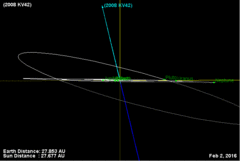2008 KV42
|
The orbit of 2008 KV42 is nearly perpendicular to the ecliptic. | |
| Discovery | |
|---|---|
| Discovered by | Brett J. Gladman, John J. Kavelaars, Jean-Marc Petit |
| Discovery date | May 31, 2008 |
| Designations | |
|
Trans-Neptunian objects | |
| Orbital characteristics[3] | |
| Epoch 2016-Jan-13 (JD 2457400.5) | |
| Observation arc | 5.35 years |
| Aphelion |
61.591 AU (9,213 Gm) 61.9 AU (barycentric) |
| Perihelion | 21.108 AU (3,157 Gm) |
| 41.349 AU (6,186 Gm) | |
| Eccentricity | 0.4895 |
| 265.90 yr | |
Average orbital speed | 4.06 km/s |
| 333.09° | |
| Inclination | 103.45° |
| 260.96° | |
| Physical characteristics | |
| Dimensions | 50[4]–90 km[5] |
| Temperature | ~41 K |
| 23.4 | |
| 8.8[3] | |
|
| |
2008 KV42 (nicknamed Drac) is the first trans-Neptunian object (TNO) with a retrograde orbit to be discovered. Its 103° inclination and its retrograde motion suggest that it is the missing link between its source in the Hills cloud and Halley-type comets, thus providing further insight into the evolution of the outer Solar System. The object measures no more than 90 km across and with a semi-major axis of 41 AU takes about 266 years to complete an orbit around the Sun.
The discovery was announced on July 16, 2008, by the Canada France Ecliptic Plane Survey team led by Brett Gladman. An official name has not been chosen because the object has not been numbered; the discovery team nicknamed 2008 KV42 "Drac" after Count Dracula.
Discovery and naming
The discovery of 2008 KV42 was announced on July 16, 2008 by the Canada France Ecliptic Plane Survey team led by Brett Gladman from the University of British Columbia.[6][7] The announcement was made during the "Asteroids, Comets, Meteors" meeting held in Baltimore, Maryland, followed by a Minor Planet Electronic Circular on the same day and a IAU Circular on July 18. The discovery was made using images obtained on May 31 from the 3.5 meter Canada-France-Hawaii Telescope, followed by further observations until July 8 from the Whipple Observatory and Cerro Tololo.[6][8][9]
The discovery team nicknamed 2008 KV42 Drac because of its high inclination in reference to its orbital plane resembling Count Dracula's ability to walk on walls.[10]
Orbit
2008 KV42 is the first trans-Neptunian object (TNO) with a retrograde orbit to be discovered. With a semi-major axis of 46±5 AU, it was discovered while at a distance of 32 AU and has a perihelion at roughly the distance of Uranus.[6] The object's 104-degree inclination makes its almost perpendicular to the ecliptic, and is, as of July 2014, one of only five objects known to have inclination (i) > 60° and perihelion (q) > 15 AU.[nb 1][11][12] Its unusual orbit suggests that 2008 KV42 may have been perturbed inwards from its source, most likely in the Hills cloud, by an unknown gravitational disturbance. Its discovery may reveal the source regions for Halley-type comets which also have an retrograde orbit, but their origin remains unknown. 2008 KV42 itself is believed to be in an intermediate stage towards becoming a comet, thus helping to further explain the formation and evolution of the outer Solar System.[4][13][14]
Planet Nine
2008 KV42 may even provide evidence of Planet Nine.[15] The Kozai effect inside the mean-motion resonances with Planet Nine may cause a periodic exchange between its inclination and its eccentricity. When the elongated perpendicular centaurs get too close to a giant planet, orbits such as that of 2008 KV42 are created.[16]
See also
Notes
References
- ↑ Marc W. Buie (2008-07-08). "Orbit Fit and Astrometric record for 08KV42". SwRI (Space Science Department). Retrieved 2008-09-15.
- ↑ Akimasa Nakamura (18 Jul 2008). "Table of Damocloid objects, or Oort cloud asteroids". Lowell Observatory. Retrieved 2008-09-16.
- 1 2 "JPL Small-Body Database Browser: (2008 KV42)" (last observation: 2013-10-06; arc: 5.35 yr). Jet Propulsion Laboratory. Retrieved 2016-01-30.
- 1 2 "Discovery of the retrograde trans-neptunian object 2008 KV42". cfeps.net. Canada France Ecliptic Plane Survey. 2008. Retrieved 23 July 2014.
- ↑ "Absolute Magnitude (H)". NASA/JPL. Archived from the original on 17 December 2009. Retrieved 2009-12-21.
- 1 2 3 "A Retrograde TNO : 2008 KV42". cfeps.net. Canada France Ecliptic Plane Survey. 2008. Retrieved 23 July 2014.
- ↑ Hecht, Jeff (September 5, 2008). "Distant object found orbiting Sun backwards". newscientist.com. New Scientist. Retrieved 23 July 2014.
- ↑ "MPEC 2008-O02 : 2008 KV42". minorplanetcenter.net. Minor Planet Center. July 16, 2008. Retrieved 23 July 2014.
- ↑ "Circular No. 8960". cbat.eps.harvard.edu. Central Bureau for Astronomical Telegrams. July 18, 2008. Retrieved 23 July 2014.
- ↑ O'Neill, Ian (September 5, 2008). "Kuiper Belt Object Travelling the Wrong-Way in a One-Way Solar System". universetoday.com. Universe Today. Retrieved 24 July 2014.
- 1 2 "JPL Small-Body Database Search Engine: i > 60 (deg) and q > 15 (AU)". JPL Solar System Dynamics. Retrieved 2013-05-29.
- 1 2 "MPC list of q>15 and i>60 (HiHq objects)". IAU Minor Planet Center.
- ↑ "Announcements – International Team of Astronomers Finds Missing Link". nrc.cnrc.gc.ca. National Research Council. September 4, 2008. Retrieved 26 July 2014.
- ↑ {{cite web url=http://adsabs.harvard.edu/abs/2009ApJ...697L..91G|title=Discovery of the First Retrograde Transneptunian Object}}
- ↑ Batygin, Konstantin; Brown, Michael E. (20 January 2016). "Evidence for a distant giant planet in the Solar system". The Astronomical Journal. 151 (2): 22. arXiv:1601.05438
 . Bibcode:2016AJ....151...22B. doi:10.3847/0004-6256/151/2/22. (called drac in reference)
. Bibcode:2016AJ....151...22B. doi:10.3847/0004-6256/151/2/22. (called drac in reference) - ↑ Brown, Mike (2016-02-12). "Why I believe in Planet Nine.". FindPlanetNine.com.
External links
- 2008 KV42 at the JPL Small-Body Database

